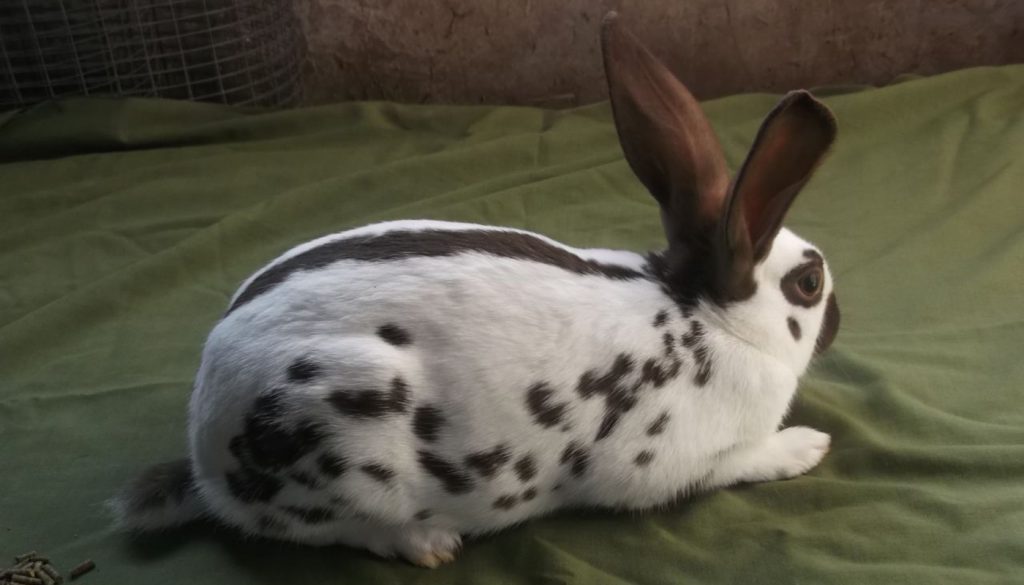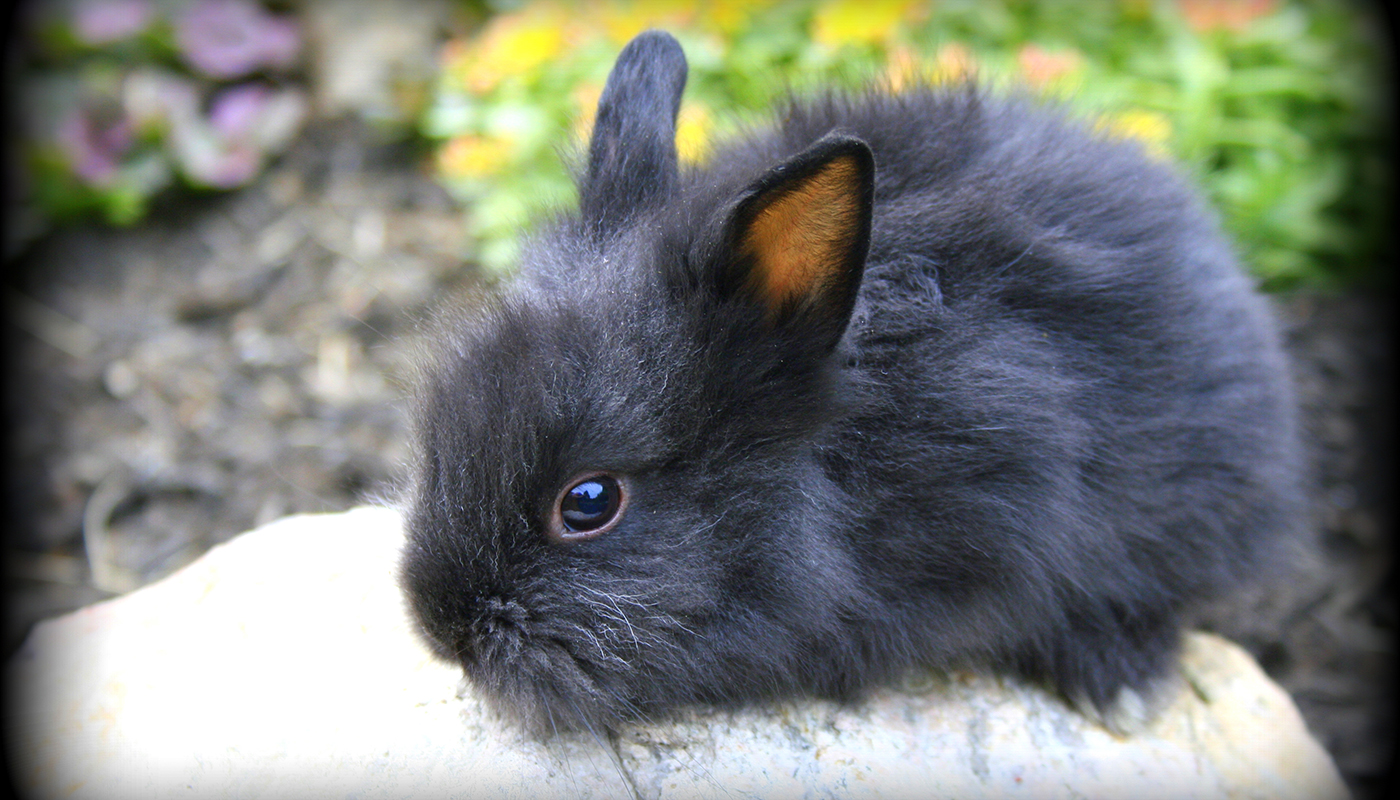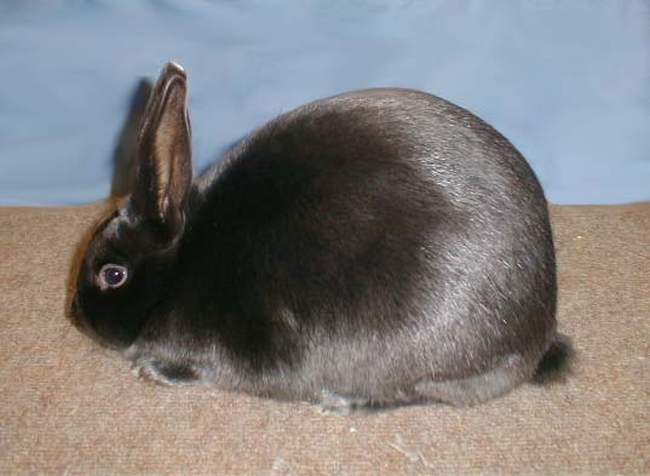
The English Spot rabbit has to be one of my favorite rabbit breeds. They are lively, active but have a wonderfully friendly and curious nature. They also have a very unique coat that has a butterfly pattern, stripes, and checks on it.
BREED PROFILE OVERVIEW
|
|
|---|---|
| Breed Name: | English Spot |
| Other Names: | None |
| Country of Origin: | United Kingdom |
| Breed Purpose: | Exhibition and pet |
| Breed Size: | Large |
| Breed Weight: |
Female/Doe: 10 to 14 lbs. Male/Buck: 10 to 14 lbs. |
| Breed Color(s): | White with a few spot colors that are accepted by the American Rabbit Breeders Association these are black, blue, grey, lilac, gold, gray, chocolate and tortoise |
| Physical Appearance: |
The English Spot rabbit has a slender fully-arched body type which is like that of a hares body type. They have long slender legs with the hind legs held parallel to the body. Their body is also slender and when they are sitting you can see clear under their bellies. They have a cute cotton tail
Their ears stand vertically from the head where they do not touch. They have a wedge-shaped face that is proportional to their body size. Their coat is short and dense of flyback type fur. The coat is white with color markings that look like checks down the sides of the body. The ears are usually the same color as the markings as is the dorsal stripe that runs along the rabbit’s spine and splotches onto its tail. Its tail tip usually is frosted with color. |
| Temperament: | Sweet, gentle, energetic, curious and fun |
BREED CHARACTERISTICS
- They have a decent sized litter and the females make very good mothers. Most rabbits have good maternal instincts and some breeds can be a bit testy and protective when they have young. They can also be uncharacteristically moody during mating season.
- Their young open their eyes around 7 to 14 days with an average of 10 days after birth. When their eyes have opened, they can start to be introduced to food such as alfa pellets and water.
- Even when the young start to eat it does not mean they are quite ready to be weaned from their mothers. The mothers will know when it is time to wean her young. It is important for the baby rabbit’s health, growth, immune system and development of a proper digestive system that they do not be removed from their mother for at least 8 weeks. They usually require her milk for a minimum of 8 weeks after birth.
- Their average lifespan is 5 to 8 years although there have been some breeds that have lived to 10 years with the proper care.
| Good Pets? | They are good pets for families with children, first-time rabbit owners, singles, seniors and they can be indoor, outdoor or both rabbits. |
| Child Friendly? | Children should be supervised around animals and properly taught how to look after them and handle them. Rabbits can bite and scratch |
| Ideal Climate: | All climates – rabbits should never be left outside without proper shelter and housing that must be raised off the ground and predator safe. |
| Conservation Status: | Not Listed by the *ALC Status/Rarity: They are not listed by the American Livestock Conservancy |
| Recognized by the ARBA? | Yes, they are recognized by the American Rabbit Breeders Association in a few different colors which are listed in the rabbit breeds color section of this article. |
| Rabbit Associations/Clubs: | American English Spot Rabbit club |
| Where to buy them? | Please refer to the American English Spot Rabbit club for more information on where to get the English Spot Rabbit Breed. The USA Rabbit Breeders Directory is a useful resource to find breeders, clubs, and information about the breed. |
| Note: *ALC stands for American Livestock Conservancy | |
GENERAL INFORMATION
For a slicker more glossy or shiny pelt, it is advisable to groom them every two to three weeks. During the molting season, it is advisable to groom rabbits every week to remove stray hairs.
Rabbits can be quite lively and energetic and need quite a bit of exercise and stimulation. It is a good idea to have a nice safe and secure run for them to play in and stretch their legs.
Toys, tubes and various obstacle courses for them is a good way to help them expend some of their energy and they are really fun to watch at play.
They are also sociable animals that do like to have a friend or two to play with.
Regular health and critter check once a week or every second week should become a habit. This will help to keep your rabbit(s) in excellent condition and health. Grooming does not require a lot if their coats are low maintenance. But it is a good idea to give them a nice gentle brushing to help remove any excess hairs regardless of the length of their coats.
It is also a good idea to check on the state of their teeth to ensure that they are not too long and causing the rabbit any discomfort.
Rabbits teeth never stop growing and getting fresh hay on a regular basis helps to control the growth of their teeth.
Rabbits need a good diet of quality pellets that are filled with their daily nutritional requirements. They do love dandelions, cabbage and various fruits as a nice tasty treat.
Rabbits that have quite a short coat are not really at risk for most of the digestive problems long fur seem to cause rabbits. They can still get other ailments such as flystrike, ear mites or overgrown teeth. These can all be controlled/maintained or avoided altogether with the proper health and grooming care of the rabbit(s).
If you have two rabbits and do not want to breed them it is possible to spay female rabbits and neuter male rabbits.
The females can be spayed as young as four months old, but vets prefer to wait until they are at least six months old before doing so.
The young males can be neutered as young as found months old.
Rabbits, just like any other pet, should be dewormed on a regular basis. Check with your local vet for proper guidance on the administering of worm medication to your animals.
HISTORY
The English Spot is quite an old rabbit breed of which is believed to have been developed in England around the 1800s.
There is information in the 1957 American English Spot Rabbit Club handbook that suggests that the English Spot was first seen in 1890 in England.
The National English Rabbit club was formed in 1891 when its beautiful markings were standardized as a breed.
One of the National English Rabbit Clubs guidebook dated 1975, documents that English Spots were exported to America in 1910 and the American English Spot Rabbit Club (AESRC) was formed in 1924.
The first “National All English” show was held in Louisville, KY in 1952.
Video
USEFUL LINKS
- American Rabbit Breeders Association
- Fur Commission USA
- North American Meat Institute
- American Livestock Conservancy
- Animal Shelter (ASPCA)
- American Veterinary Medical Association
- American Animal Welfare Society
- American Animal Control
- American Society of Animal Science
- United States Department of Agriculture
- United States Department of Agriculture – Rabbit Meat
 Florida White Rabbit – Everything You Need to Know
Florida White Rabbit – Everything You Need to Know 10 Best Meat Rabbit Breeds
10 Best Meat Rabbit Breeds Himalayan Rabbit – Everything You Need to Know
Himalayan Rabbit – Everything You Need to Know 18 Rabbit Breeds to Keep as Pets
18 Rabbit Breeds to Keep as Pets Beveren Rabbit – Everything You Need to Know
Beveren Rabbit – Everything You Need to Know Top 10 Best Small Rabbit Breeds to Keep as Pets
Top 10 Best Small Rabbit Breeds to Keep as Pets Thrianta Rabbit – Everything You Need to Know
Thrianta Rabbit – Everything You Need to Know Giant Angora Rabbit – Everything You Need to Know
Giant Angora Rabbit – Everything You Need to Know English Lop Rabbit – Everything You Need to Know
English Lop Rabbit – Everything You Need to Know Crème D’Argent Rabbit – Everything You Need to Know
Crème D’Argent Rabbit – Everything You Need to Know Satin Rabbit – Everything You Need to Know
Satin Rabbit – Everything You Need to Know 13 Giant Rabbit Breeds You Love to Know
13 Giant Rabbit Breeds You Love to Know